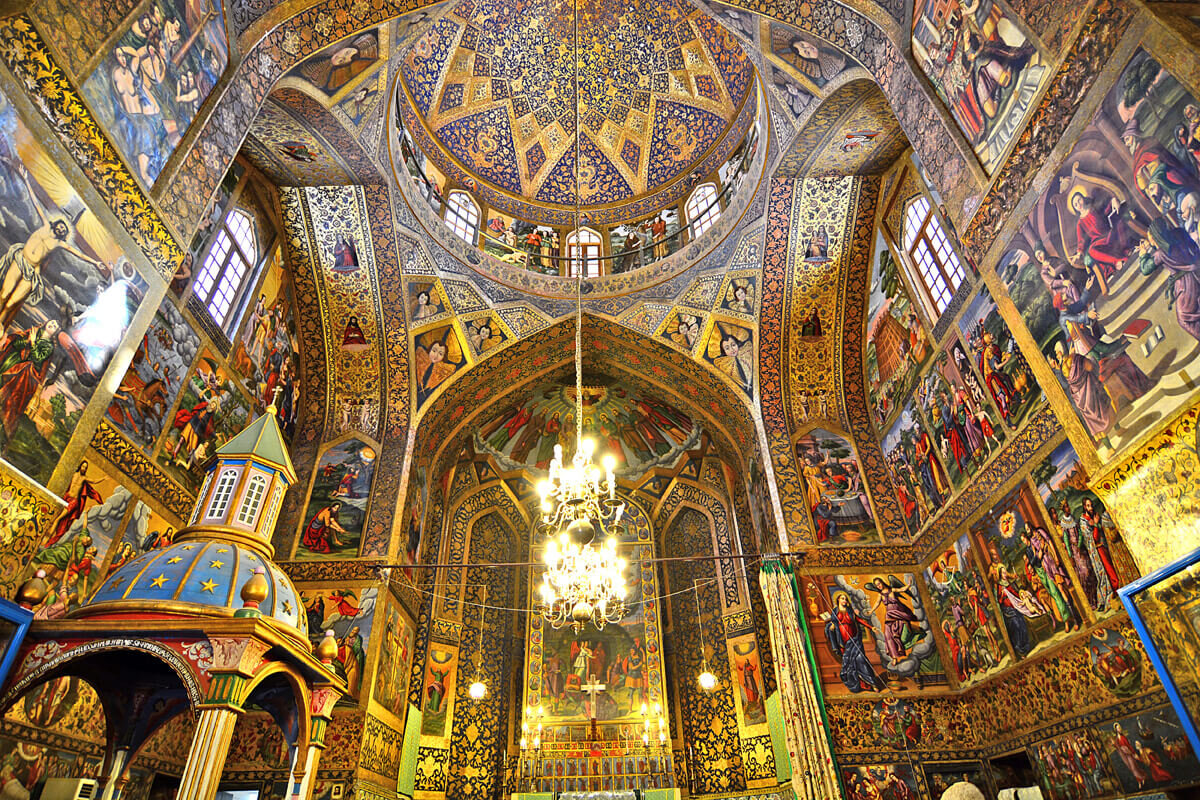Blog
Armenian Vank Cathedral, Vank Church Isfahan

Armenian vank cathedral, Isfahan, Iran: A Safavid Legacy and Armenian Identity

The Holy Savior Vank Cathedral (Vank, meaning “monastery” in Armenian), located in the historical New Jolfa quarter of Isfahan, is more than just a religious site—it is a rare historical and artistic document. This masterpiece narrates a complex story of politics, migration, trade, and artistic synthesis in the heart of the Persian plateau, standing as a vivid symbol of cultural coexistence during the Safavid era. For travelers booking Iran tour packages, Vank Cathedral is an essential highlight.
History of Vank Cathedral: The Armenian Migration and the Birth of New Jolfa
The cathedral’s foundation is intrinsically linked to one of the most critical decisions made by Shah Abbas the Great in the early 17th century. To bolster the economy of his new capital, Isfahan, and strategically impede the Ottoman advances, Shah Abbas ordered the forced relocation of a large population of skilled Armenian merchants and artisans from Old Jolfa on the Aras River.
These highly influential migrants, specialized in silk trade and craftsmanship, established a new district known as New Jolfa on the south bank of the Zayandeh River. Shah Abbas, recognizing their economic value, granted them conditional religious freedom and special trade privileges. This strategic move transformed New Jolfa into a vital center for global commerce and cultural exchange between East and West.
The construction of Vank Cathedral, which began in the 1650s and was completed in 1664, served as a powerful declaration of the community’s stability and renewed prosperity. Locating the church in New Jolfa, separate from the Muslim quarters, was crucial for the Armenians to maintain their identity, language, and traditions.
Architecture and Decoration: The Art of Iranian and Armenian Synthesis

Vank Church Library, Isfahan
Vank Cathedral’s architecture is a distinct fusion of Armenian structural styles and Persian decorative arts, making it a unique feature on any list of Isfahan Tourist Attractions.
- External Structure: Unlike traditional Armenian churches, which are typically stone-built, Vank is constructed primarily from brick and shares some structural characteristics with Safavid mosques and caravanserais. The building features two domes. The larger central dome is conical on the exterior (typical of Armenian churches) but rises from the inside in the elaborate, high-domed style of Persian architecture. The use of glazed tilework on the lower exterior walls is an exceptional feature for an Armenian church, reflecting direct Iranian influence.
- The Fresco Masterpiece: The cathedral’s global fame stems from its extraordinary interior decorations. Every surface, from the domes to the walls, is covered with rich oil and watercolor paintings. Although the themes are purely Christian (depicting Genesis, the life of Christ, and scenes of Heaven and Hell), the execution is deeply influenced by the Persian Safavid artistic tradition.
- Artistic Blending: The extensive use of warm colors, elaborate gold leaf, Gol-o-Morgh (flower and bird) motifs, and Persian floral patterns gives the interior a luxurious, Oriental splendor. This blending of Christian narrative with Persian aesthetics makes Vank a living museum of religious art, where two distinct cultures merge beautifully.
Cultural Significance and Impact on Armenian History
The significance of Vank Cathedral extends far beyond its artistic beauty; it became the cultural and political heart of the Armenian community in Iran.
- Preserving Identity: The complex has been vital in safeguarding the Armenian language, script, and heritage. The Vank Library and Museum, one of Isfahan’s oldest museums, houses thousands of invaluable manuscripts, royal decrees, historical documents, and unique artifacts, including a hair-woven embroidery piece.
- Diplomatic Role: The Armenians of Jolfa, leveraging their linguistic skills and global trade networks, served as key economic and diplomatic representatives for the Safavid monarchs in Europe and Asia. The impressive architecture of Vank Cathedral itself acted as a symbol of the Safavid ruler’s tolerance and respect for Christianity, a valuable tool in their political and commercial dealings with European powers.
Conclusion:
Vank Cathedral is a brilliant example of cultural management and religious tolerance under the Safavid dynasty, allowing a minority community not only to survive but to flourish and contribute significantly to the capital’s economic and artistic zenith. Travelers interested in historical Isfahan tours and profound cultural sites will find Vank Cathedral an unforgettable stop, symbolizing the enduring relationship between Iranian and Armenian cultures.
Recent Posts
Tours
-
 Yazd city tour
$110 – $140Price range: $110 through $140
Yazd city tour
$110 – $140Price range: $110 through $140
-
 Iran desert stargazing tour, Mahan Desert Star Eco Camp (Full-board & luxury tour)
$365 – $475Price range: $365 through $475
Iran desert stargazing tour, Mahan Desert Star Eco Camp (Full-board & luxury tour)
$365 – $475Price range: $365 through $475
-
Luxury desert camp Iran $810 – $950Price range: $810 through $950
-
Private Tehran Shiraz Isfahan tour cost (6 days) $670 – $1,000Price range: $670 through $1,000
-
Kerman multi-day tours $265 – $355Price range: $265 through $355













Recent Comments